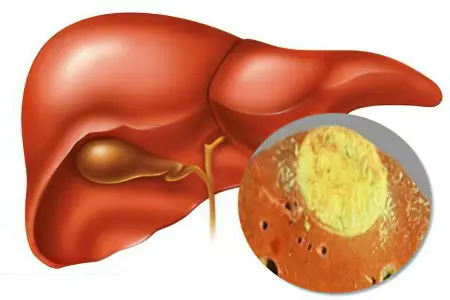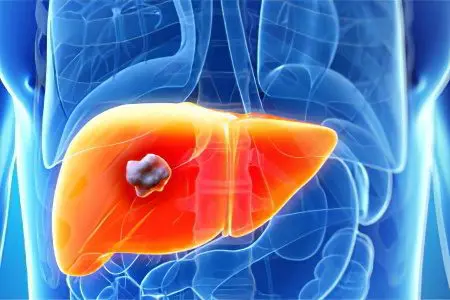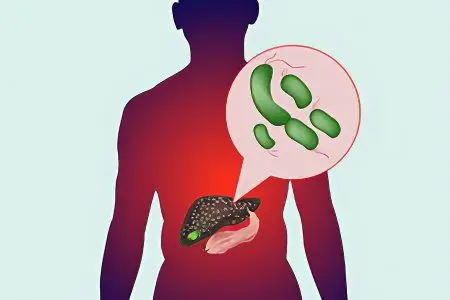Contents
Liver abscess is a consequence of the inflammatory process in the parenchyma of the organ, which led to necrosis and the formation of a cavity filled with pus. The main category of patients with liver abscess is middle-aged and older patients. The disease is secondary, that is, it occurs as a result of other pathologies. Among all purulent formations of the abdominal cavity, the liver abscess accounts for 48% of the total number of cases, that is, it is recorded quite often. Men get sick 2,5 times more often than women.
Classification

According to the place of localization, an abscess of the right and left lobe of the liver is distinguished. An abscess in the right lobe occurs 5 times more often than in the left lobe.
By etiology:
Parasitic;
Bacterial.
By pathogenesis:
Hematogenous abscess – the infection got into the liver with a blood stream;
Cholangiogenic abscess – the source of infection penetrated from the biliary tract;
Contact, post-traumatic abscess – an abscess arose as a result of a wound or injury to the abdominal organs;
Cryptogenic abscess – has an unidentified source of infection, occurs in 10% of cases.
According to the cause of the occurrence, a primary and a secondary abscess are distinguished. Single and multiple lesions of the liver with purulent cavities are diagnosed.
Causes and pathogenesis of liver abscess

An important condition for the spread of the inflammatory process in the liver tissues is a decrease in local and general immunity. Most often, the infectious process is provoked by streptococcus and Staphylococcus aureus, Klebsiella, Escherichia coli, enterobacteria, anaerobic bacilli, mixed flora. They enter the liver as a result of the following diseases and conditions:
Cholelithiasis;
Cholecystitis;
Cholangitis;
Oncological lesions of the biliary tract (cholangiocarcinoma), pancreas;
Sepsis, colorectal cancer;
Appendicitis;
Ulcerative colitis;
Diverticulitis;
Invasion of echinococcus, roundworm, dysenteric amoeba;
The spread of colonies of the fungus of the genus Candida as a result of chemotherapy of the digestive tract or leukemia;
The consequences of taking steroids and cytostatics;
Liver injuries, complications after operations on this organ;
Parasitic and non-parasitic liver cysts;
Specific granulomas of the liver.
Once in the liver, colonies of bacteria multiply, destroying the cells of its parenchyma. As a result, an infiltrate, necrotic areas are formed. After melting of the liver tissues, a cavity filled with pus is formed, limited by a capsule of fibrous tissue.
Parasites enter the liver from the intestine through the portal vein system. So they take the form of tropoizotes and completely clog the capillaries of the liver. Hepatocytes are deprived of nutrition, areas of necrosis appear, where necrosis is formed.
At risk are patients suffering from cirrhosis of the liver, diabetes mellitus, pancreatic pathologies, oncological diseases of the digestive tract, as well as the elderly, and those who have undergone liver transplantation.
Symptoms

The main symptom is constant dull pain of a aching nature under the right lower rib, radiating to the shoulder, under the shoulder blade. The pain syndrome is accompanied by a feeling of heaviness, aggravated when the patient lies on his right side.
Other manifestations of an abscess:
An increase in the liver, noticeable on palpation, it protrudes from under the costal arch;
Pain on palpation;
Decreased or lack of appetite;
Nausea;
Flatulence;
Diarrhea;
Hyperthermia, chills;
Manifestations of intoxication (tachycardia, heavy sweat, weakness);
Yellow coloration of the sclera of the eyes;
Earthy complexion;
Sudden loss of body weight;
Hiccough caused by irritation of diaphragm by enlarged liver.
Complications of the disease

The prognosis for the development of a liver abscess can be extremely unfavorable if all possible measures for its treatment are not taken.
Consequences of untreated liver abscess:
Peritonitis, sepsis resulting from the rupture of an abscess and the outflow of pus, necrotic tissues into the abdominal cavity;
Subdiaphragmatic abscess due to accumulation of pus under the dome of the diaphragm;
Pericarditis, pericardial tamponade of the heart due to the ingress of pus into the pericardial sac;
Ascites;
Bleeding due to increased pressure in the collar vein system;
Abscess of brain structures;
Septic pulmonary embolism;
The development of fistulas in the lungs and in the pleura due to the breakthrough of an amoebic abscess into the pleural cavity.
Diagnostics

Since it is difficult to differentiate a liver abscess from diseases similar in symptoms, it is important to correctly assess the patient’s complaints and his anamnesis. The doctor finds out the nature of complaints, the presence of foci of infections, operations, injuries, serious illnesses.
Laboratory studies in the diagnosis of liver abscess:
General analysis of blood and urine – an increase in the number of leukocytes, reduced hemoglobin, a shift in the leukocyte formula is recorded;
A blood test for biochemistry – an increase in bilirubin, alt, alkaline, ast;
Bacterial blood culture – important in the search for the causative agent of infection;
Analysis of feces for extraintestinal amoebiasis, for cysts of dysenteric amoeba;
Examination of aspirate of purulent exudate taken by percutaneous puncture.
Methods of instrumental diagnostics:
X-ray of the abdominal cavity – reveals signs of ascites, the presence of a cavity in the liver with fluid and pus;
Ultrasound of the hepatobiliary system – determines the size and location of the abscess cavity;
MRI, MSCT of the abdominal cavity – evaluates the location, number and size of abscesses to clarify the tactics of treatment;
radioisotope scanning of the liver – reveals defects in the blood supply to the liver, localization of the abscess;
diagnostic laparoscopy – a miniature camera and instruments are inserted through small incisions into the abdominal cavity to drain the abscess.
It is important to distinguish liver abscess from purulent cholecystitis, pleurisy, subdiaphragmatic abscess.
Treatment of a liver abscess

A liver abscess is treated by a surgeon, a gastroenterologist, and, if necessary, an infectious disease specialist. Standard tactics include antibiotic therapy in combination with minimally invasive interventions.
Possible manipulations and procedures:
Abscess drainage under ultrasound guidance;
Installation for 3-7 days of drainage catheters to remove pus with bacteriological examination of aspirate;
Intravenous administration of antibiotics (Amoxiclav, Clindamycin, Ceftriaxone);
Treatment with antiprotozoal agents (Metronidazole, Tinidazole, Diloxanide);
With candidiasis, drip administration of Amphotericin B;
Surgical excision of affected tissues in the treatment of complicated abscess;
Diet No. 5 during the recovery period after a course of treatment.
To prevent the appearance of a liver abscess, it is necessary to treat diseases that provoke the development of this pathology in a timely manner.









